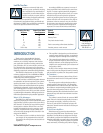7
Play music with a good strong bass line and
crawl on the floor on your hands and knees until
you find a spot where the bass sounds the best,
with a smooth, tight response. Your ears need
to be at the same height that the subwoofer’s
driver will be when it is sitting on the floor. If
you have access to a real-time analyzer (RTA),
play pink noise over the system and use the
RTA to find a location that exhibits the flatest
bass response. Once you’ve found the place
where the bass sounds the best, put the
subwoofer there and it should sound just as
good from your listening position.
Polarity
The setting of the polarity switch can affect
how the low frequencies sound in relation to the
main speakers. Listen to bass-heavy music with
the polarity switch in and out. In one position
the low frequencies should sound full, while in
the other position they may sound hollow and
thin. Choose the position that yields the fullest
low-frequency sound.
Feel free to experiment
In many respects, every room is unique in
terms of its acoustics. Even after you’ve placed
your subwoofer where you think it’ll sound
best, try moving it around. You might be pleas-
antly surprised.
Additional Tidbits of Wisdom
• Avoid using EQ to compensate for dips in
the frequency response caused by room
modes. It is better to place the subwoofer in
a position where dips are minimized and
use the EQ to smooth out any peaks.
• Provide at least six inches clearance
around the heatsink to allow air to get at it.
• Provide at least three feet clearance from a
TV, computer monitor, or any form of
magnetic media (video and audio recording
tapes, computer disks, etc.), to prevent the
HR150’s powerful magnet from distorting the
video screen or erasing the magnetic media.
• When you shut down your equipment, turn
off the HRS150 powered subwoofer first
(and any other powered speakers in the
system) to prevent thumps and other
noises generated by any upstream equip-
ment from coming out the speakers. When
powering up, turn on the powered speakers
and subwoofer last.
• Save the shipping box! You may need it
someday, and you don’t want to have to pay
for another one.
• Save your sales receipt in a safe place.
• Also record the HRS150 serial number in the
space provided on the inside front cover,
along with where and when you bought it.
A Few Words About THX™ pm3™
Certification
Nearly two decades ago, George Lucas
turned a passion for great sound into the
world’s most accepted and trusted solution for
achieving it. The standard was named THX
(for Tomlinson Holman, who developed the
THX Sound System when he was the research
and technical director at Lucasfilm Ltd.™ in
the early 80s), and today, with hundreds of
thousands of home theater customers and
more than 3000 THX Certified movie theaters
enjoying its benefits, the THX name has be-
come nothing short of legendary. Simply put:
when it comes to premium sound, no other
name so closely defines ‘quality’ for millions of
movie-goers and home theater enthusiasts alike.
Today, a new landscape is emerging. A land-
scape comprised of hundreds of small,
professional multi-channel facilities, whose
need for differentiation, expert technical and
marketing support, and a true, multi-channel
standard is becoming a competitive fact of life.
Again, THX has a singular solution and this
time it’s called THX pm3 Certification.
All facilities involved with mixing and/or moni-
toring of multi-channel material should have the
option to use pm3. THX pm3 Certification is ideal
for DVD mastering, sweetening, and mixing; and
is also perfect for facilities doing work in broad-
cast, music, or multi-media applications.
HRS150 THX pm3 Certification
Anyone seeking THX Certification for their
studio, or striving to maintain THX standards,
can use the HRS150s and rest assured that
their facility is in full compliance.


















